APAC Aviation Market Size
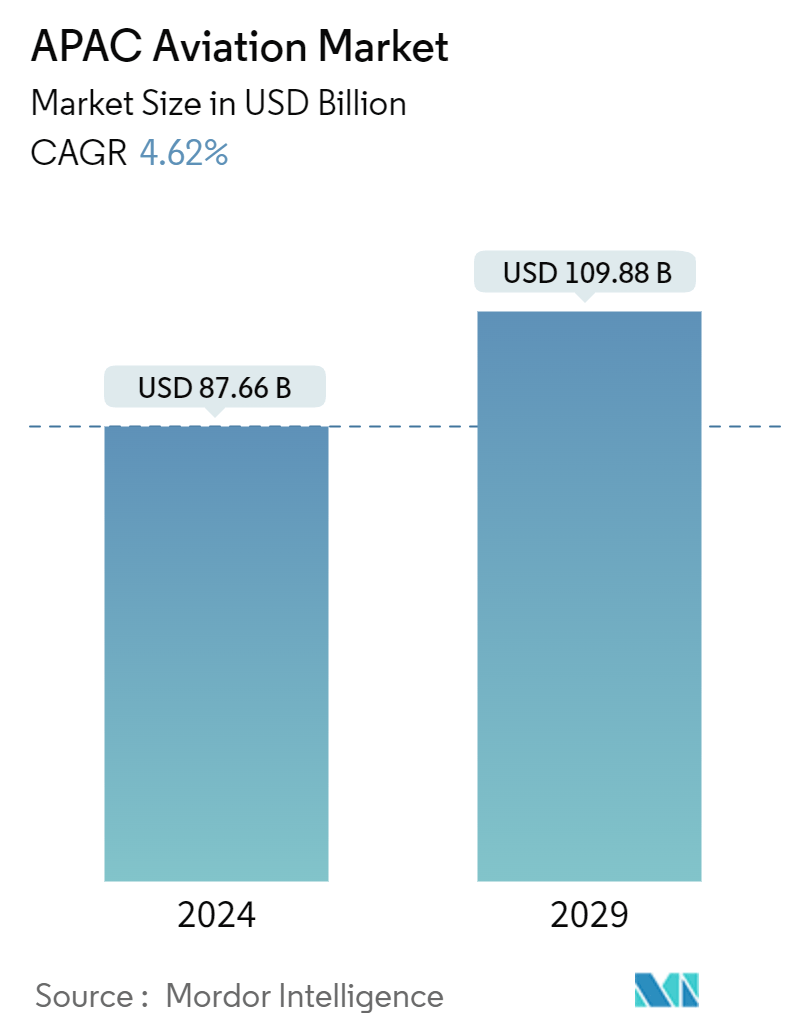
| Study Period | 2019 - 2029 |
| Base Year For Estimation | 2023 |
| Market Size (2024) | USD 87.66 Billion |
| Market Size (2029) | USD 109.88 Billion |
| CAGR (2024 - 2029) | 4.62 % |
| Market Concentration | Medium |
Major Players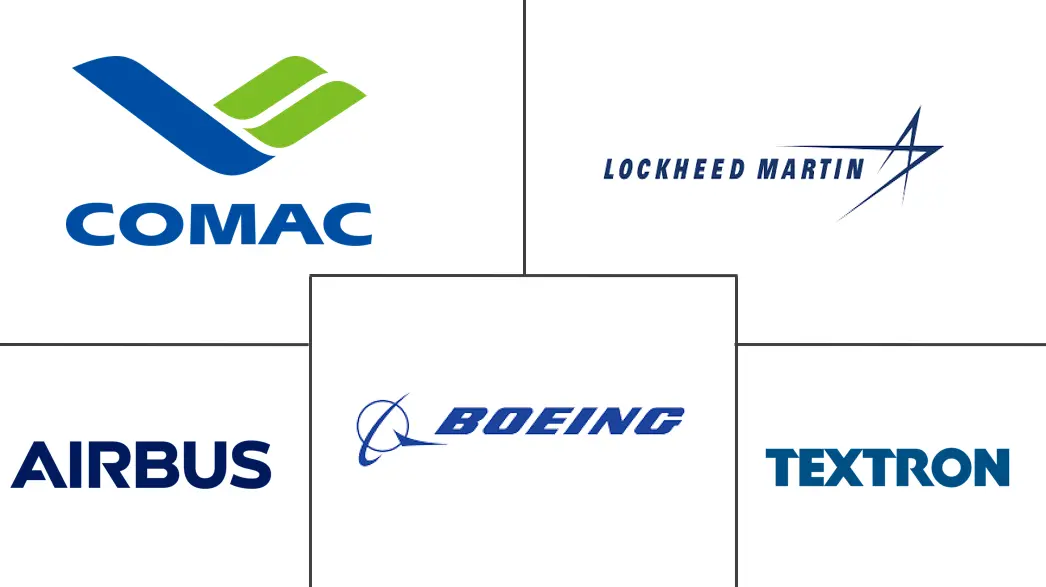
*Disclaimer: Major Players sorted in no particular order |
APAC Aviation Market Analysis
The APAC Aviation Market size is estimated at USD 87.66 billion in 2024, and is expected to reach USD 109.88 billion by 2029, growing at a CAGR of 4.62% during the forecast period (2024-2029).
The Asia-Pacific aviation market is witnessing robust growth, driven by several key factors. The expanding middle class and rising disposable incomes fuel a significant uptick in air travel demand. Moreover, strong economic growth in nations like China, India, and Southeast Asia propels market expansion. Additionally, the relaxation of air transport regulations and proactive government measures to enhance air connectivity and infrastructure may further catalyze market growth.
The industry is seeing the development of fuel-efficient, low-emission aircraft. Increasingly stringent emission regulations are further driving market growth. Furthermore, the aviation landscape is evolving, with digital technologies like AI, IoT, and big data analytics revolutionizing operations, maintenance, and crew management. These technology integrations boost operational efficiency, elevate safety standards, and enhance passenger experiences.
While the aviation market in the region holds a positive outlook, it faces numerous challenges. High operational costs, particularly in fuel and maintenance, stand out as primary constraints to market growth. Additionally, the industry grapples with stringent regulations on safety and operations, demanding substantial investments in compliance. Furthermore, a persistent challenge looms in the form of a shortage of skilled human resources, from pilots to maintenance staff.
The military aviation industry in Asia-Pacific is buoyed by escalating defense budgets, notably in countries like China and India. These nations allocate significant portions of their increased defense budgets to bolster and expand their air force fleets. This surge is primarily attributed to heightened national security concerns and escalation of regional geopolitical tensions. Notably, acquisitions are heavily focused on advanced fighter jets and surveillance aircraft, further propelling growth in military aviation. For instance, in 2023, China's defense budget stood at USD 230 billion, marking a 7.1% year-on-year increase. Similarly, India allocated approximately USD 70 billion for defense, with a significant portion earmarked for enhancing its air force capabilities.
APAC Aviation Market Trends
The Commercial Aviation Segment is Projected to Witness the Highest Growth During the Forecast Period
Asia-Pacific, known for its rapid economic growth, has witnessed a surge in disposable incomes, making air travel more accessible. This has led to a proliferation of low-cost carriers (LCCs) across the region, democratizing air travel and pushing costs down. These carriers rapidly expand their fleets and routes to meet the rising demand, resulting in a notable uptick in new commercial aircraft deliveries.
Moreover, regional governments are increasingly liberalizing air services and streamlining bilateral air service agreements. These policy changes boost flight frequency and route expansions and drive up the demand for aircraft to cater to these additional flights.
Boeing's outlook for the Asia-Pacific commercial aviation market is optimistic. The company forecasts that regional carriers will need around 18,600 new airplanes by 2042. This growing fleet will boost capacity and integrate newer, more efficient technologies, aligning with global sustainability goals.
In a significant move in April 2023, Airbus bolstered its presence in the aviation market through a major deal with China Aviation Supplies Holding Co. The deal involved the sale of 160 aircraft, comprising 150 units from the A320 Family and 10 A350-900 widebody aircraft. This strategic move highlights the strong demand from Chinese carriers across all market segments. Airbus is setting up a second assembly line in Tianjin to support this momentum, effectively doubling its current capacity. This expansion is crucial, as the Tianjin facility is set to produce 20% of all single-aisle aircraft globally, significantly contributing to Airbus's goal of manufacturing 75 aircraft per month by 2026.
Additionally, the collaboration emphasizes Airbus's commitment to sustainability, with a focus on developing an efficient supply chain for sustainable aviation fuels. The partnership aims to incorporate these fuels by up to 10% by 2030, showcasing not just China's importance in Airbus's global strategy but also the dynamic growth of the aviation market in Asia-Pacific.
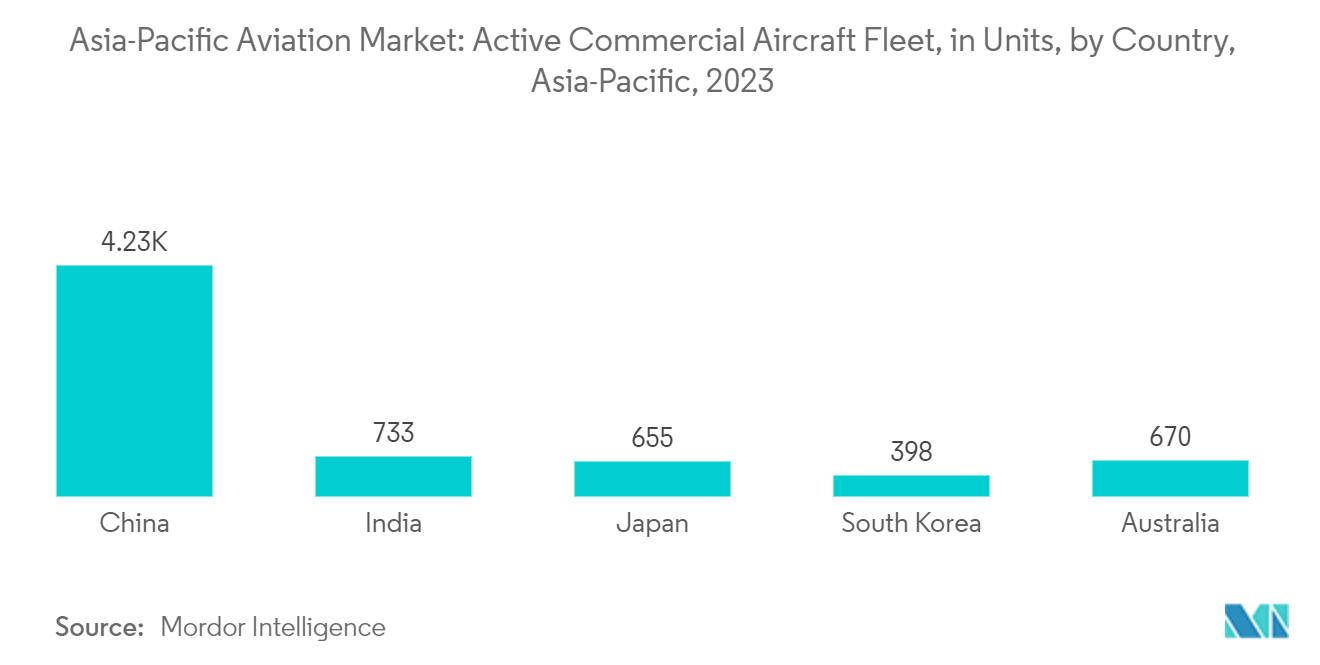
China to Continue Market Dominance During the Forecast Period
The Chinese government is taking a proactive stance in fortifying its aviation industry at home and on the global stage. It directs substantial investments toward airport infrastructure, with a focus on expanding existing facilities and building new ones to cater to surging passenger numbers. As a clear testament to its ambitions, China is eyeing a target of over 400 local airports by 2035.
As one of the world's largest and fastest-growing economies, China's aviation market is significantly influenced by its increasing urbanization and the rising disposable incomes of its populace. The expanding urban middle class is fueling a heightened demand for both domestic and international air travel, ensuring a buoyant aviation industry.
In a bid to challenge the dominance of Boeing and Airbus, China has significantly bolstered its aircraft manufacturing capabilities in recent years. Spearheaded by companies like Commercial Aircraft Corporation of China (COMAC), known for models such as the C919 and ARJ21, these efforts not only cater to domestic needs but also position China as a formidable global aviation player. A recent milestone in this trajectory was Air China's announcement in April 2024, where the company placed a substantial order for 100 COMAC C919 jets valued at USD 10.8 billion. These jets, slated for delivery between 2024 and 2031, are set to pose a strong challenge to established models like the B737 MAX and Airbus's A320neo. This deal not only cements COMAC's standing in the aviation realm but also signals a strategic pivot by Chinese carriers toward domestic manufacturers.
China's military strategy significantly emphasizes enhancing its air force capabilities, a pivotal aspect of its broader defense modernization agenda. This includes notable advancements in fighter jets, transport aircraft, and unmanned aerial vehicles, all aligning with China's overarching goal of bolstering national defense and augmenting its global influence. China's commitment to indigenous aircraft manufacturing, exemplified by creations like the J-20 stealth fighter and the Y-20 military transport aircraft, underscores its drive to lessen dependence on foreign technology and achieve self-sufficiency in critical military assets.
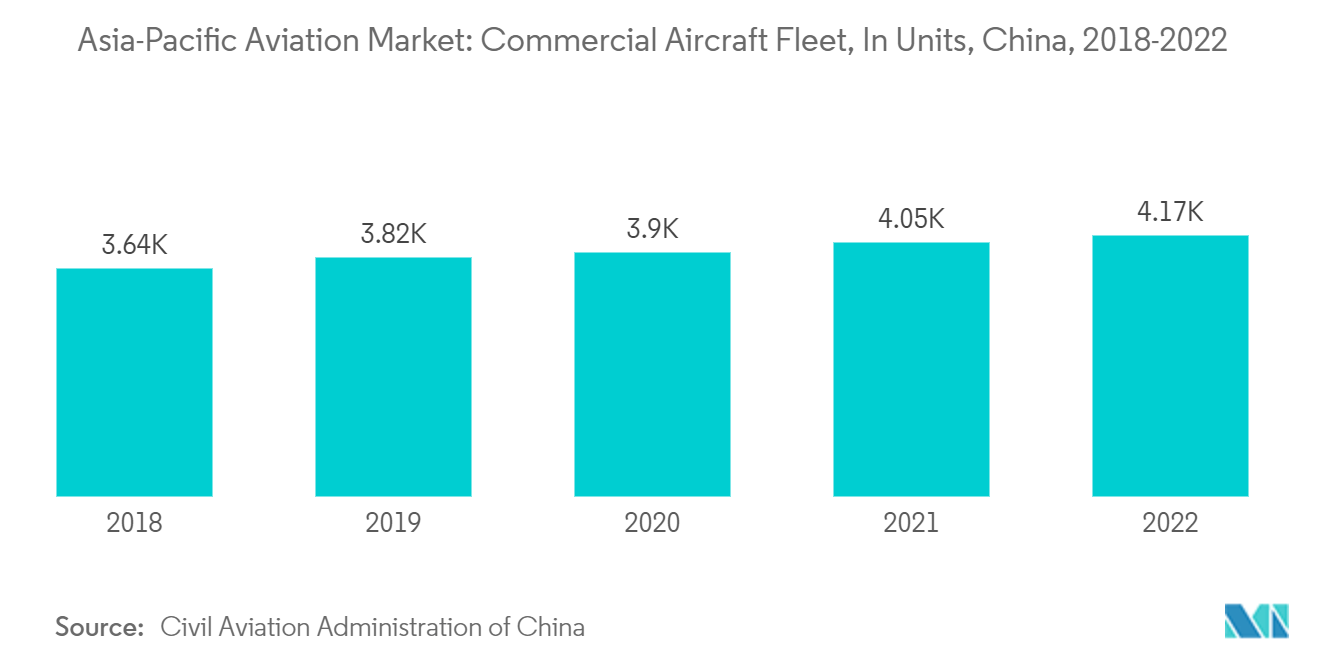
APAC Aviation Industry Overview
The Asia-Pacific aviation market is characterized by a semi-consolidated landscape, with key players like The Boeing Company, Airbus SE, Lockheed Martin Corporation, Commercial Aircraft Corporation of China Ltd, and Textron Inc. Local manufacturers like the Aviation Industry, Hindustan Aeronautics Limited, and Kawasaki Heavy Industries are also actively vying for market share.
The initiatives by regional governments are also bolstering the market's growth, particularly in fostering indigenous aircraft development. Notably, nations such as China, India, Japan, South Korea, and Indonesia are intensifying efforts in military aircraft development. For instance, Korean Aerospace Industries is spearheading the development of the KF-X (KF-21 Boramae) fighter aircraft, aimed at replacing aging models in the Republic of Korea Air Force's fleet.
Bell Textron Inc., a subsidiary of Textron Inc., reported strong sales for its Bell 505 helicopter in Asia-Pacific in February 2024. Noteworthy contracts with Malaysia, Indonesia, and the Philippines underscore the sustained demand for these aircraft. At the Singapore Airshow 2024, Malaysian MRO firm Hammock Helicopter secured a notable purchase agreement for two corporate-configured Bell 505 helicopters, leading the new orders at the event.
APAC Aviation Market Leaders
-
Lockheed Martin Corporation
-
Airbus SE
-
The Boeing Company
-
Textron Inc.
-
Commercial Aircraft Corporation of China Ltd.
*Disclaimer: Major Players sorted in no particular order
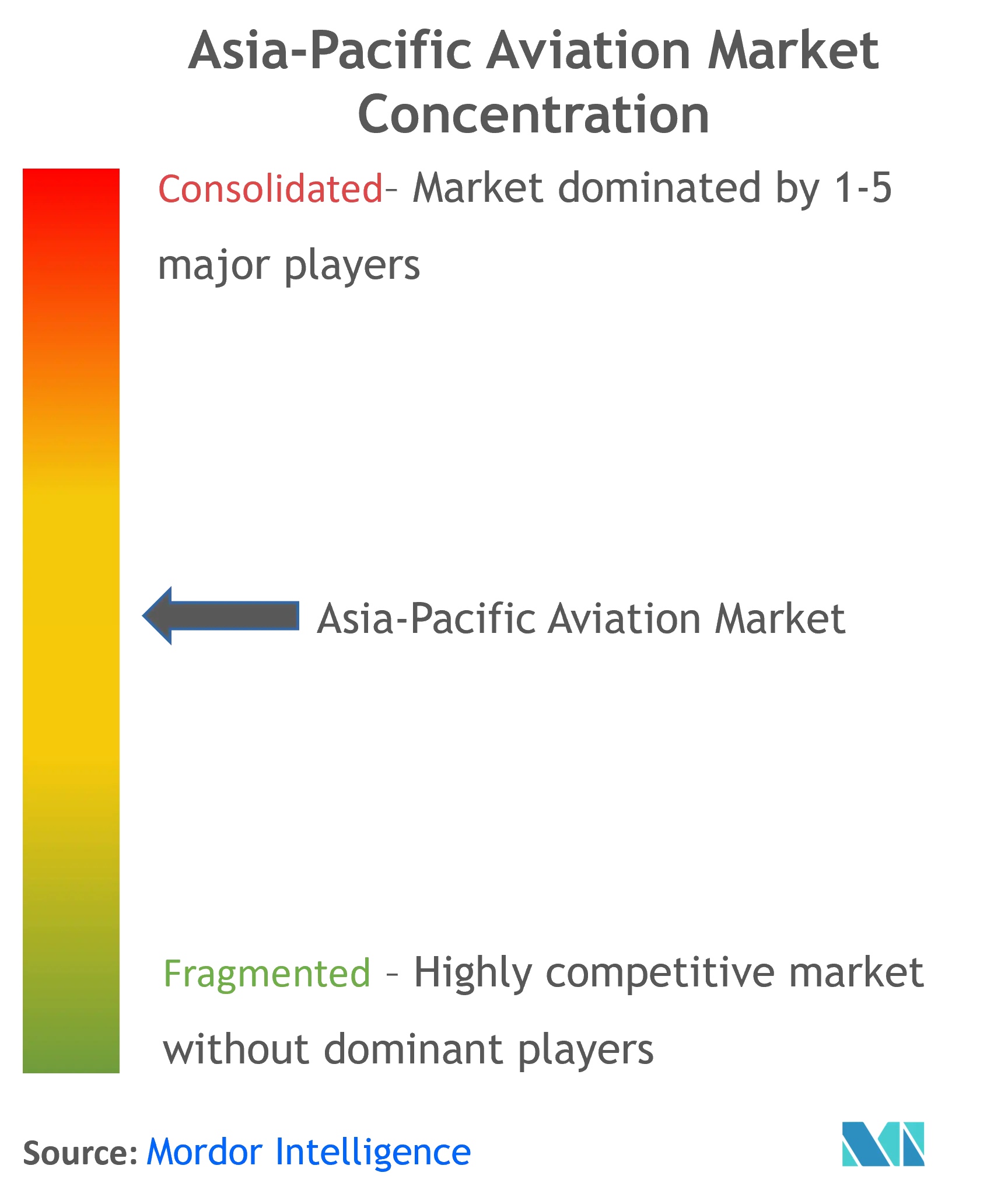
APAC Aviation Market News
July 2023: Elbit Systems signed a USD 114 million contract to deliver two long-range patrol aircraft (LRPA) to a country in Asia-Pacific. This deal highlights the region's escalating appetite for cutting-edge surveillance and patrol capabilities. Over the next five years, Elbit Systems will outfit two new ATR 72-600 aircraft with an advanced suite of technologies. Each craft will boast a top-of-the-line mission management system, integrating the latest in electro-optics, radar, SIGINT, and communication systems.
April 2023: Airbus significantly bolstered its presence in the Asia-Pacific aviation market, sealing a substantial deal with China Aviation Supplies Holding Co. The agreement entails the purchase of 160 aircraft, with 150 from the A320 family and 10 A350-900 widebodies. This move highlights the strong demand from Chinese carriers and aligns with Airbus's growth strategy. To this end, Airbus is setting up a second assembly line in Tianjin to double its production capacity. This strategic move may position Tianjin to handle 20% of the world's single-aisle aircraft, a crucial step toward Airbus's global target of 75 aircraft per month by 2026.
Asia Pacific Aviation Market Report - Table of Contents
1. INTRODUCTION
- 1.1 Study Assumptions
- 1.2 Scope of the Study
2. RESEARCH METHODOLOGY
3. EXECUTIVE SUMMARY
4. MARKET DYNAMICS
- 4.1 Market Overview
- 4.2 Market Drivers
- 4.3 Market Restraints
-
4.4 Industry Attractiveness - Porter's Five Forces Analysis
- 4.4.1 Threat of New Entrants
- 4.4.2 Bargaining Power of Buyers/Consumers
- 4.4.3 Bargaining Power of Suppliers
- 4.4.4 Threat of Substitute Products
- 4.4.5 Intensity of Competitive Rivalry
5. MARKET SEGMENTATION
-
5.1 Type
- 5.1.1 Commercial Aviation
- 5.1.1.1 Passenger Aircraft
- 5.1.1.2 Freighter
- 5.1.2 Military Aviation
- 5.1.2.1 Combat Aircraft
- 5.1.2.2 Non-combat Aircraft
- 5.1.3 General Aviation
- 5.1.3.1 Helicopter
- 5.1.3.2 Piston Fixed-wing Aircraft
- 5.1.3.3 Turboprop Aircraft
- 5.1.3.4 Business Jets
-
5.2 Geography
- 5.2.1 China
- 5.2.2 India
- 5.2.3 Japan
- 5.2.4 South Korea
- 5.2.5 Australia
- 5.2.6 Rest of Asia-Pacific
6. COMPETITIVE LANDSCAPE
-
6.1 Company Profiles
- 6.1.1 Airbus SE
- 6.1.2 Textron Inc.
- 6.1.3 Lockheed Martin Corporation
- 6.1.4 Dassault Aviation SA
- 6.1.5 Leonardo SpA
- 6.1.6 Kawasaki Heavy Industries Ltd
- 6.1.7 General Dynamics Corporation
- 6.1.8 The Boeing Company
- 6.1.9 Hindustan Aeronautics Limited (HAL)
- 6.1.10 Honda Motor Co. Ltd
- 6.1.11 Commercial Aircraft Corporation of China Ltd
- 6.1.12 Korea Aerospace Industries Ltd
- 6.1.13 Aviation Industry Corporation of China
- *List Not Exhaustive
7. MARKET OPPORTUNITIES AND FUTURE TRENDS
** Subject To AvailablityAPAC Aviation Industry Segmentation
The Asia-Pacific aviation market covers the sales of both fixed-wing and rotary-wing aircraft in the commercial, military, and general aviation industries. It provides insights into air passenger traffic, aircraft orders, defense spending, the launch of new routes, and regional investments in aviation.
The market studied is segmented by type and geography. By type, the market is segmented into commercial aviation, military aviation, and general aviation. The commercial aviation segment is further segmented into passenger aircraft and freighter. The military aviation segment is further segmented into combat and non-combat aircraft. The general aviation segment is segmented into helicopters, turboprop aircraft, piston fixed-wing aircraft, and business jets. The report also offers the market size and forecasts for five countries across the region. For each segment, the market sizes and forecasts are provided in terms of value (USD).
| Type | Commercial Aviation | Passenger Aircraft |
| Freighter | ||
| Type | Military Aviation | Combat Aircraft |
| Non-combat Aircraft | ||
| Type | General Aviation | Helicopter |
| Piston Fixed-wing Aircraft | ||
| Turboprop Aircraft | ||
| Business Jets | ||
| Geography | China | |
| India | ||
| Japan | ||
| South Korea | ||
| Australia | ||
| Rest of Asia-Pacific |
Asia Pacific Aviation Market Research FAQs
How big is the APAC Aviation Market?
The APAC Aviation Market size is expected to reach USD 87.66 billion in 2024 and grow at a CAGR of 4.62% to reach USD 109.88 billion by 2029.
What is the current APAC Aviation Market size?
In 2024, the APAC Aviation Market size is expected to reach USD 87.66 billion.
Who are the key players in APAC Aviation Market?
Lockheed Martin Corporation, Airbus SE, The Boeing Company, Textron Inc. and Commercial Aircraft Corporation of China Ltd. are the major companies operating in the APAC Aviation Market.
What years does this APAC Aviation Market cover, and what was the market size in 2023?
In 2023, the APAC Aviation Market size was estimated at USD 83.61 billion. The report covers the APAC Aviation Market historical market size for years: 2019, 2020, 2021, 2022 and 2023. The report also forecasts the APAC Aviation Market size for years: 2024, 2025, 2026, 2027, 2028 and 2029.
Asia Pacific Aviation Industry Report
Statistics for the 2024 Asia Pacific Aviation market share, size and revenue growth rate, created by Mordor Intelligence™ Industry Reports. Asia Pacific Aviation analysis includes a market forecast outlook to 2029 and historical overview. Get a sample of this industry analysis as a free report PDF download.



